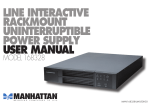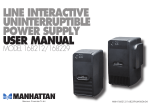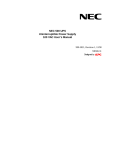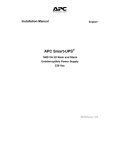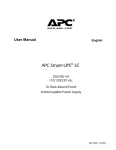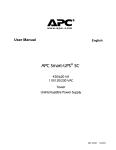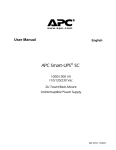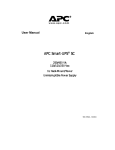Download Manhattan 168175 uninterruptible power supply (UPS)
Transcript
line interactive uninterruptible power supply USER MANUAL MODEL 168120/168175 MAN-168120/168175-UM-0606-06 Thank you for purchasing the MANHATTAN ® Line Interactive Uninterruptible Power Supply, Model 168120 or 168175. This uninterruptible power supply (UPS) is designed to keep computers and peripheral devices operating after a utility power failure that could result in component damage or loss of data. Whenever the UPS is plugged in, it maintains a full charge on its battery and serves to protect your equipment from utility-generated surges and noise. It also provides visual and audible indicators that alert you to utility line failures, giving you ample time to save files and close operations. Among the main features: • Advanced protection for PC and Macintosh systems against power outages, sags, surges and line noise • Built-in microprocessor maintains proper charge, provides consistent power output and helps extend battery life • Automatic voltage regulation (AVR), cold start capability and diagnostics • 480 Joules telephone, fax and network surge protection • Fuse protection from overload and short circuit events • LED and audible alert system and power management software help monitor critical functions • $100,000 connected equipment guarantee (US and Canada only) • Lifetime Warranty, UPS; Three-year Warranty, battery Package contents: •Line Interactive UPS Model 168120 (500 VA / 300 W) or Model 168175 (1000 VA / 600 W) •UPS Monitor Software CD •Connecting Cables •User Manual safety instructions Prior to its operation, inspect this product for damage. If any damage is found, notify your dealer. Keep the carton and packing foam in the event the product must be returned to the factory for service (damage sustained in transit when shipped from the user is not covered under warranty). •Place the device indoors in an area that has adequate airflow and is free from excessive dust. Do not allow the UPS to be exposed to moisture, rain, excessive heat or direct sunlight. •Use of this product in life-support applications — where failure of this device can reasonably be expected to cause failure of life-support equipment or to significantly affect its safety or effectiveness — is not recommended. •Always disconnect the input power cord from the wall outlet before replacing the battery. •Do not dispose of the battery in a fire, as the battery may explode. •Do not open or mutilate the battery, as it contains a toxic electrolyte harmful to both the skin and eyes. •Proper disposal of the battery is required. Refer to your local laws/regulations regarding battery disposal. •When replacing batteries, use the same number and type as listed in Specifications. Only use tools with insulated handles, and remove watches, rings and bracelets. operation & installatioN This MANHATTAN Line Interactive UPS can protect your equipment from surges, spikes, blackouts, brownouts and line noise. When AC power is present and the UPS is turned on, it continues to charge the battery and provide power to the equipment directly from the AC line. The battery can provide stable power to complete your work, save data and safely shut down your system when the utility power has failed. The UPS is simple to operate and install. Following are the steps for connecting equipment to the UPS. Conditions Do not operate the UPS in an environment where the ambient temperature is outside the limits given in the Specifications section of this manual. Connection to the Utility Power Plug the UPS into an electrical outlet. Do not plug it into an outlet that already uses a heavy electric load (e.g., an air conditioner, refrigerator or laser printer). 120 V AC Version The 120 V AC version of the MANHATTAN Line Interactive UPS is furnished with a line cord terminated with a standard NEMA 5-15P three-pronged plug. The UPS must be plugged into a two-pole, three-wire grounding receptacle. If an extension cord must be used, use a three-wire grounding type rated at least 8 Amps. Plug the UPS into a two-pole, three-wire grounded receptacle only. Avoid using extension cords and adapter plugs. 220 V AC Version The 220 V AC version is furnished with one output power cord for connection to computer equipment having IEC 320 male appliance couplers at their input. In most cases this will not be a problem, as the input cord that currently powers your computer equipment may be swapped with the supplied output cord. Hence, the swapped output line cord can be used instead as the input line cord for the UPS. Initial Battery Charging The UPS is shipped from the factory with its internal battery fully charged. However, the battery may lose some charge during shipping and storage. The battery should be recharged before conducting the following test for proper operation and to ensure the UPS will provide expected run time. The UPS automatically charges the battery whenever the UPS is plugged in (the On/Off/Test switch doesn’t have to be turned on). You can be sure that the battery is fully recharged if the UPS is left plugged in for at least eight hours. Connecting Your Equipment to the UPS To ensure that your computer equipment will be protected during a utility failure and that you receive expected run time, it is important that the total power needs of the equipment not exceed the capacity of the UPS. The UPS will emit a loud tone and the yellow LED will illuminate to alert you of an overload. Consult your dealer for the power requirements of your equipment. Once you have determined that your equipment and the UPS are compatible, plug your equipment into the rear panel output receptacles of the UPS. Test for Proper Operation Push the On/Off/Test button to turn on your computer equipment. The green NORMAL indicator on the front panel should be illuminated and your equipment should operate normally. To test the operation of the UPS, simply unplug its input cord to simulate a utility blackout. The UPS will immediately transfer your equipment loads to power derived from its internal battery. During this time, the UPS will emit two beeps once every 10 seconds to remind you that your equipment is operating from a source of power that is limited in duration. Restore power to the UPS by plugging in the line cord. Repeat this test four or five times to ensure proper operation. Another way to test the operation of the UPS is to simply press and hold the On/Off/Test button for two seconds or more, and then release it to run a self-test routine. The UPS will immediately transfer your equipment to power derived from its internal battery and run a self-test. See the next section if abnormal operation is encountered. Overloads and Output Shorts If the total power requirement of your equipment is much greater than the capacity of the UPS, the UPS rear-panel circuit breaker may trip. (120 V model 168175 and the 220 V versions have a fuse instead of a circuit breaker.) Once the breaker is tripped, the UPS will attempt to operate the load using its internal power source. The UPS will emit a loud tone before it shuts down and ceases to power your equipment. The yellow LED will be illuminated and stay on to alert you of the overload until the UPS is started up again. In this case, turn off the UPS and decide which equipment is to be left unprotected by the UPS. Once the overload or short circuitry is released, reset the input circuit breaker on the rear panel by pressing the button in. Then re-start the UPS. Do not plug laser printers into this device, as their power requirements are much greater than the capacity of the UPS. Connection for Telephone/Network Surge Suppression Connect a single-line telephone or 10 Base-T network cable into the telephone/network surge protection sockets on the rear panel of the UPS. The RJ-11/RJ-45 modular combination sockets accept all standard single-line telephone and 10 Base-T connections. The cable coming from the telephone service or networked system is connected to the port marked IN; the OUT port is connected to the equipment to be protected. controls & indicators 5 4 3 2 1. On/Off/Test Button: This button controls power to the UPS and its output receptacles. Press and hold the button one to four seconds to switch on the UPS. Press and hold the button two to three seconds when the utility power is normal, and the UPS will simulate a utility outage and perform its self-test function. It provides a convenient means of testing the UPS’s battery. Push the button during a utility failure (when the UPS is off), and the UPS will re-start and provide power to its output receptacles. During a utility power outage, the UPS will emit one beep every five seconds. Press and hold the button for two seconds to silence the beep. 1 2.Replace Battery LED: The LED lights when the UPS detects that the battery needs to be replaced soon. Charge the UPS at least four hours. If the LED lights again after charging, the battery might need replacing. 3.Overload LED: During an overload operation, the UPS will emit a loud tone and this LED will come on. See Troubleshooting to recover the UPS. 4.On-line LED: During normal operation, this indicator always stays on. When the automatic voltage regulator is in operation, this LED blinks. 120 V Model 168120 shown. Indicators are similar for 220 V version and both versions of Model 168175. 5.On-battery LED: In on-battery operation, the on-battery LED illuminates and the UPS will sound two beeps once every ten seconds. The UPS will emit a steady tone when the battery reserve runs low until either the AC returns or the UPS shuts down from battery exhaustion. 6.AC Power Cord: Complete the necessary power connections. For Model 168120 (120 V), use an existing NEMA-type PC power cord to connect the PC to the UPS. Use the included NEMA-type power cord to connect the UPS to the power source. For 220 V models, use the included IEC-type power cord to connect the PC to the UPS. Use one of the existing PC power cords to connect the UPS to the power source. 9 7. Surge Protection (Bypass) Outlets: These protect against 6 surges and spikes. 10 11 10 11 8 7 6 8.Battery Backup & Surge 120 V Models 168120, left; 168175, right. Output ports for 220 V models will vary in number and Protection Outlets: These type. See Specifications. provide emergency battery backup power, as well as surge protection. 9. Input Circuit Breaker/Fuse: The UPS will trip the circuit breaker (or blow the fuse) when the loads exceed the UPS capacity. The re-settable button extends when tripped. 10.Communications Port: This connects the UPS to your computer via an RS-232 serial cable. (UPS monitor software is included.) NOTE: The UPS can work independently without an RS-232 connection. 11. Telephone/Network Surge Suppression: The RJ-11/45 module connectors are used for single-line telephone and 10 Base-T surge protection. NOTE: This connection is not needed to use the UPS. indicator table The UPS has both visible (LED) and audible (alarm) status indicators. The LED numbers correspond to the Indicator images on page 7. Replace Overload Battery LED LED Red (2) Yellow (3) On X X On X X X X On X On-Line LED Green (4) X X On X X On-Battery LED Alarm Green (5) X X X Constantly on X X On 2 beeps @ 10-second intervals On 2 beeps @ 1-second intervals UPS Status Indication Bad battery Overload AC mode DC mode Low battery troubleshooting Symptom Possible Cause Action to Take The UPS will not turn UPS is not plugged into an AC Plug the UPS in and turn it on. If power is still not on. outlet and/or is not turned on.present, make sure the circuit breaker on your building is not accidentally turned off. Output short overload shutdown. Reduce the load and reset the circuit breaker (or replace the blown fuse if so designed). Computer interface or accessory Disconnect the interface, then press the computer problem. reset button. All LEDs are lit and Internal UPS system fault. Return the UPS for service. the UPS is emitting a constant tone. The UPS doesn’t provide The battery is not fully charged. Remove all connected equipment from the UPS and expected run time. charge the battery for at least 8 hours. (While the battery is charging, turn the UPS off to prevent any unnecessary discharging.) The battery is old or bad. Return for service. Other LEDs are off but The UPS is shut down and the None. The UPS will return to normal operation when the Replace-battery LED battery is discharged due to an the power is restored and the battery regains a is blinking. No alarm is extended power outage. sufficient charge. sounding, but the UPS is not operating. 10 Specifications Available in 120 V (NEMA) and 220 V (IEC) models Model 168120 • Outlets: 3 NEMA (120 V), 3 backup + surge only; 2 IEC (220 V), 2 back-up + surge • Times: - Backup: 3 minutes at full load; 10 minutes at 50% load; 30 minutes at varying loads (typical with PC and 15” LCD monitor at 85 W) - Recharge: 8 hours typical (12 hours maximum) - Transfer: 4 ms typical (10 ms maximum) • Communications port: RS232 (120 V); RS232 (220 V) • Telephone/fax/network ports: RJ-11/RJ-45 (1 in / 1 out), surge protected • Nominal voltage: input, 100 V/110 V/120 V (220 V/230 V/240 V); output, 120 V (230 V) • Voltage range: input, 96 V – 138 V (174 V – 262 V) • Frequency range: input, 50/60 Hz +/– 5 Hz (auto sensing) • Voltage regulation: output, +/– 5% (battery mode) • Frequency regulation: output, 50/60 Hz +/– 1% • Automatic voltage regulation (AVR): 120 V and 220 V models • Waveform: simulated sine wave • Overload protection: 110% warning and UPS shutoff after 10 seconds; 120% UPS turnoff at once • Battery: capacity, 12 V / 7 Ah; type, sealed and maintenance-free (lead acid) • Temperatures (°C): operation, 0 to 40; storage, -20 to 60 11 • Operation relative humidity: 0 to 95% (non-condensing) • LED indicators: Online, Overload, On Battery and Bad Battery • Audible alarms: Overload, On Battery, Low Battery Package Contents • Line Interactive UPS, 500 VA / 300 W • Power Management Software CD (Windows 98/SE/Me/2000/XP compatible) • Cables: RS232, 6 ft. (1.8 m); telephone (RJ-11), 6 ft. (1.8 m); power cord, 6 ft. (1.8 m) • User manual Model 168175 • Outlets: 5 NEMA (120 V), 4 backup + surge / 1 surge only; 3 IEC (22O V), 3 backup + surge • Times: - Backup: 5 minutes at full load; 12 minutes at 50% load; 35 minutes at varying loads (typical with PC and 15” LCD monitor at 85 W) -Recharge: 8 hours typical (12 hours maximum) -Transfer: 4-6 ms typical (10 ms maximum) • Communications port: RS232 (120 V); RS232 (220 V) • Telephone/fax/network ports: RJ-11/RJ-45 (1 in / 1 out), surge protected • Nominal voltage: input, 100 V/110 V/120 V (220 V/230 V/240 V); output, 120 V (230 V) • Voltage range: input, 96 V – 138 V (174 V – 262 V) • Frequency range: input, 50/60 Hz +/– 5 Hz (auto sensing) 12 • Voltage regulation: output, +/– 5% (battery mode) • Frequency regulation: output, 50/60 Hz +/– 1% • Automatic voltage regulation (AVR): 120 V and 220 V models • Waveform: simulated sine wave • Overload protection: 110% warning and UPS shutoff after 10 seconds; 120% UPS turnoff at once • Battery: capacity, 12 V / 5 Ah x 2; type, sealed and maintenance-free (lead acid) • Temperatures (°C): operation, 0 to 40; storage, -20 to 60 • Operation relative humidity: 0 to 95% (non-condensing) • LED indicators: Online, Overload, On Battery and Bad Battery • Audible alarms: Overload, On Battery, Low Battery Package Contents • Line Interactive UPS, 1000 VA / 600 W • Power Management Software CD (Windows 98/SE/Me/2000/XP compatible) • Cables, RS232, 6 ft. (1.8 m); telephone (RJ-11), 6 ft. (1.8 m); power cable, 6 ft. (1.8 m) • User manual 13 WARRANTY INFORMATION Coverage For the original purchaser of this MANHATTAN Uninterruptible Power Supply residing in the United States or Canada, the device itself features a lifetime warranty covering material and workmanship (with a three-year warranty on the battery). Should the UPS fail, it will either be repaired or replaced (manufacturer’s option). Should UC-, UL-, CSA- or CE-listed electronic equipment connected to the MANHATTAN Uninterruptible Power Supply be damaged by power or phone line transients such as spikes or surges, the manufacturer has the option of repairing or replacing the damaged equipment or keeping the damaged equipment and paying fair market value for it (not to exceed a total of $100,000). This warranty does not cover a) damage caused by improper installation, repairs, servicing or alterations; b) damage due to the improper packing or shipping of items returned to the manufacturer; c) damage to electronic equipment that is not UC-, UL-, CSA- or CE-listed; d) damage to UC-, UL-, CSA- or CE-listed equipment not caused by power or phone line transients such as spikes or surges; e) damage caused by a failure to use properly wired and grounded electrical outlets, telephone service and, if applicable, cable TV service; f) damage caused by a failure to install primary protection devices for power and telephone service equipment; g) damage caused by cable TV transients; or h) damage caused during any use of this device for which it was not intended. Note: Some states do not allow the exclusion or limitation of incidental or consequential damages, which means the above may not apply. This warranty gives you specific legal rights. You may also have other rights, which vary from state to state. Implied Warranty Implied warranties, including the implied warranty of merchantability and the implied warranty of fitness for 14 a purpose, end when the original purchaser no longer owns the product and three years from the date of purchase for the battery. Note: Some states do not allow time limitations on implied warranties, which means the above limitations may not apply. 15 MANHATTAN offers a complete line of PC Components, Peripherals, Cables and Accessories. Ask your local computer dealer for more information or visit us online at ® www.manhattan-products.com Copyright © MANHATTAN All products mentioned are trademarks or registered trademarks of their respective owners.

















